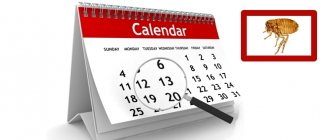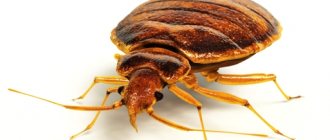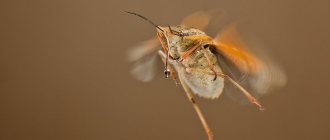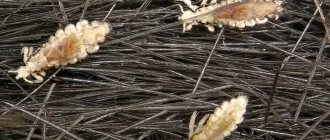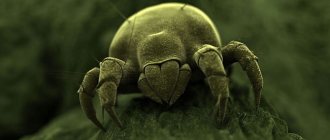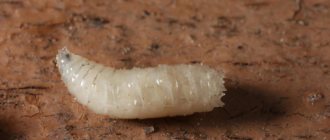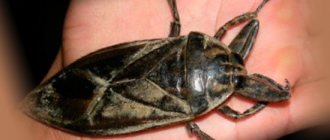Bedbugs – an insect that feeds on blood, the body shape is flattened, oval from 3 to 9 mm.
The color and shape of bedbugs depends on age and condition. For example, hungry bugs have a brown color (flat body), while well-fed ones have a bright brown color (narrow, long body).
In everyday life, bedbugs are called:
- sofa bug
- bed bug
- furniture bug
- mattress bug
- house bug
- linen bug, etc.
There are a variety of names associated with the habitat of bedbugs: beds, sofas, upholstered furniture, armchairs, etc.
The insect brings many problems if it settles in an apartment. In many cases, a person simply does not understand why itchy bumps appear on the body. The fact is that a home bug bite cannot always be distinguished from a mosquito bite. In order not to confuse insect punctures with wounds caused by mosquitoes and fleas, you need to know the main differences. Let's talk about this in detail.
Why do bedbugs bite?
Bedbugs bite people to survive and continue to reproduce. A bedbug needs blood to go through all stages of development from egg to adult.
Why don't all family members get bitten?
Often during treatments, when talking with people, they are surprised that one of the family members was bitten completely; the others have no symptoms of bites.
Bed bugs prefer to “meal” on the bodies of women and children. This is explained by the fact that their skin is more delicate and thin. The smallest blood vessels are close to the surface (especially in a child). In addition, women and children do not have such a pronounced body odor, which can obscure the aroma of blood.
Main versions:
- blood type (version not confirmed, because bedbugs cannot determine blood type by smell)
- the amount of carbon dioxide produced by the victim when exhaling; bedbugs find a food source by “smell”; the more carbon dioxide a person exhales, the more attractive it is to the bedbug.
- the distance of the victim from the nest, bugs are very shy and prefer to feed closer to the nesting site, this, in my opinion, is the most realistic version..
- softer skin in children and women; bedbugs do not divide their victims by gender, species, age; if the bug is hungry, it can also attack animals: cats, dogs, bats, etc.
- Blood vessels in children are closer to the skin.
Why don't everyone get bites?
As we discussed above, bedbugs bite everyone without exception, but everyone’s reaction to bites is different, some have very pronounced symptoms, others upon awakening do not observe traces of bites and they are not bothered by them.
The feelings of an adult and a child after a visit from a “bed bloodsucker” are completely different. Men are not as susceptible to parasite attacks as children. In many cases, they simply do not notice that they have become a feeding site at night. In addition, many do not even know what bites look like. By morning, the redness in the area of the wound may completely disappear and nothing will remind you of the visit of uninvited guests.
- In 70% of people, bites do not appear at all (the bite site quickly passes)
- 30% suffer from bedbug bites (bumps, pain, severe itching), severe allergic reactions, rashes all over the body, and chills are possible. When such patients go to the clinic, inexperienced doctors begin to treat them for allergies.
Types of water bugs
The four most common families in the world are:
- water strider;
- smoothie;
- rower;
- Belostoma.
Each of these types has its own unique characteristics.
Water strider bug
Water striders stand out among their group in their mode of movement and hunting. These insects do not dive into the depths of water, but spend the active period of their life on its surface.
The body shape of water striders is thin and highly elongated. Like all insects, it has three pairs of legs. The two rear pairs of legs are adapted for moving on the surface of the water. The insect's low weight and large support area do not allow it to break through the surface tension film of the liquid. Pushing off the surface with its feet, the water strider glides through the water. The front paws are used to hold food. The water strider feeds on floating microscopic inhabitants of the reservoir and other insects that fall into the water. Food is not found very often, so water striders have to move around a lot in search of food.
Hidden under the hard elytra are transparent wings, which water striders use very reluctantly. Flights occur only when unfavorable conditions occur in the native body of water and over short distances. Once on land, the water strider does not stop moving, but only slows down significantly.
Smooth water bug
This insect has a boat-like body. The way it moves is original and further enhances its resemblance to this ship. When immersed in water, the smoothie turns over with its belly up and begins to work hard with its hind paws-oars. At the same time, huge eyes allow you to observe the upper layers of water in search of prey. Noticing the victim, the smoothie rushes headlong at it. The main diet of smoothies consists of small underwater animals and their larvae.
The airy film, which adheres to the hairs that densely cover the entire body, helps the smoothie stay under water for a long time. The smoothie gets the necessary supply of air by floating to the surface and exposing the back of its body to the atmosphere.
The wings of the smoothie are highly developed and allow it to make long flights. He often uses this in search of water bodies richer in food. Gladfish can live not only in large ponds, but also in small puddles and even in barrels of water. If there is not enough prey, the bug leaves the hunting grounds and looks for a new place. Prefers to travel at night.
Streaked water bug
From a distance, the paddlefish can be mistaken for a smoothfish due to its swimming method. The locomotor system of the rower consists of two powerful legs ending in large area of hair-cilia. However, he prefers to move in the usual manner - with his back up. To replenish the supply of air, it floats to the surface and accumulates atmosphere under the elytra. A large air bubble pushes the body up, and it has to be held on by the leaves and stems of aquatic plants to prevent it from floating up.
The paddlefish is similar to its terrestrial relatives in the presence of scent glands. The secretions from them scare off potential enemies. At the same time, the smell helps to attract individuals of the opposite sex.
The peculiarity of the rower is that it also “sings”. The sound is made by rubbing the front paws on the proboscis. In nature, people can very rarely hear a rowing sound, since the sound strength is very small, and it also comes from under the water. Some people keep these bugs in aquariums with fish, and in the silence of the apartment you can hear the quiet “voice” of the bug.
Belostoma - a giant water bug
The name itself speaks volumes about the size of the insect. If most of its relatives have a body length of 1-2 cm, then the Belostoma grows into a 10-centimeter giant. For life, it prefers to choose shallow reservoirs with very warm water. Therefore, belostomas (swordsworts) are widespread, mainly in the tropics. Although there are species that have adapted to lower temperatures and have colonized the Far East.
Belostoma is nocturnal. It attacks its prey from ambush, infecting it with a nerve agent. Careless frogs, small fish and miniature turtles become victims of the predator. He attacks fauna not only smaller than himself, he is not afraid to choose larger specimens as victims. In some countries he even received the nickname “fish killer”.
The strongly developed front legs are equipped with large hooks that help to hold caught prey. The shape of the "combat" limbs resembles the claw of crabs or, rather, the front legs of a praying mantis. Like the others, it has wings, but flies only when necessary.
What do bedbug bites look like?
Characteristic features of bedbug bites:
- bite diameter is from 0.1 - 1 mm.
- at a time the bug makes 6-8 punctures, looking for a suitable blood vessel
- red spots in the form of a track, most often located along one blood vessel
- the spots have a clear outline; you can see a puncture from the bite in the center
- bites are more common on the legs, arms, shoulders, open areas of the body; bedbugs do not bite the face
- slight swelling, redness, burning of the bite site, itching
- bites appear at night
- bites appear in winter, when there are no other insects
Blood-sucking parasites prefer to feed collectively. Therefore, in the morning, on the body of an adult or child, you can find rows of characteristic reddish swellings arranged in the form of lines. This is another sign that allows you not to confuse bedbugs and wounds with mosquito bites.
How long does it take for signs of a bite to appear?
This factor is influenced by what stage of development you were bitten. An adult injects an anesthetic when biting and the victim does not feel the bite until the bug hides in a cozy place (itching appears after about fifteen to twenty minutes), “small” bugs bite without “anesthesia”, which is why we see traces of caught, crushed bugs during treatments .
How to distinguish bedbug bites from other insects
Flea bites
Bed bug bite marks are difficult to distinguish in appearance from damage caused by mosquitoes and house fleas. But there are differences. In the case of bedbugs, the wounds are painful when touched and have clear boundaries. Visually, they look like a red swelling with a bump in the middle.
There are several signs and symptoms:
- grouping and multiplicity . This helps distinguish bedbug damage from any other type. The insect pierces the skin and drinks only one drop of blood. Then it moves to a new area. Thanks to this, the bites look like a path (see photo below);
- linearity. The wounds are arranged in a strict linear sequence. This is another sign-symptom that helps not to confuse the rash with bites;
- number of wounds . Each parasite can make up to five punctures per feeding, located at a distance of three to four centimeters from each other. This also helps to distinguish bedbug bites.
Mosquito bite
Myths - what bedbugs are not afraid of
- Ultrasonic repellers. These are devices that may work against mammals (not always), but are absolutely useless against insects. This is due to the fact that insects do not have organs that could detect ultrasound. Therefore the effect is zero.
- Solutions and products that do not have a strong odor. The use of chemicals is based on the fact that insects have a heightened perception of aromas. Solutions of salt or soda will not bring any result.
- Magnetic traps and magnetic resonance repellers. Useless against any insects.
The main rules in the battle against pests are common sense and systematicity. With sufficient persistence, you can cope with the infection using home remedies.
Are bedbug bites dangerous?
Are bedbug bites dangerous for humans? Without a doubt. Do not forget that the insect feeds on the blood of different people. This means that the parasite can be a carrier of various diseases for a long time, transmitting the pathogen to a new “client”. This is the main danger. A person can get serious infections such as:
- viral hepatitis;
- plague;
- tularemia;
- Q fever, etc.
- allergic reactions
It is worth noting that there are few cases of infection with serious diseases after an attack by bed bugs, but, nevertheless, doctors warn about this possibility.
Allergic reactions
A possible allergic reaction is no less dangerous (see photo). During feeding, the parasite injects saliva into the wound, which contains special anesthetic components. They can cause a violent allergic reaction in a child and an adult man or woman.
What do the symptoms of the pathological condition look like? Differently. Allergy symptoms are usually divided into local reactions and general ones.
Most often, an attack by bloodsuckers ends with the development of such manifestations of an allergen that has entered the blood, such as:
- itching;
- the appearance of swelling;
- redness.
These allergy symptoms may go away on their own. But if the itching is severe, then the damage can be treated with any antihistamine.
Bed bug saliva can also cause general allergy symptoms. These reactions include:
- hives Reddish rashes appear on the body of a child or adult. They will look like a nettle burn and be accompanied by itching;
- runny nose and watery eyes. The symptoms resemble the onset of acute respiratory infections, but disappear after taking an antihistamine;
- bronchospasm. Its appearance is dangerous due to the development of breathing difficulties;
- Quincke's edema. This is one of the most serious consequences, in which swelling of the larynx is possible;
- anaphylactic shock. In this case, the victim needs urgent medical attention.
If the manifestation of allergies is limited to a runny nose, itching or slight swelling, then it is enough to use any antihistamine. In other cases, accompanied by severe swelling or difficulty breathing, qualified medical assistance is necessary.
In the photo you see waste products of bedbugs. They can also provoke severe allergies. The reaction may be unpredictable.
Allergies during pregnancy
Bed bugs pose a danger to pregnant women, since if an allergy develops, taking any antihistamines without prior medical advice is prohibited. Even slight swelling of the larynx is especially dangerous for a pregnant woman. During this period, the child experiences oxygen starvation, which is not very good for the developing brain of the fetus. To treat an allergy to bed bugs, a pregnant woman should contact a leading physician.
Temperature
Frost and sun are all truly wonderful, but not for bedbugs. Any temperature effects that go beyond comfortable conditions can be detrimental to these bloodsuckers. The optimal interval for their life is from +20 to + 30 degrees. At higher or lower temperatures, many life processes are inhibited (the bug does not reproduce, does not eat, and almost does not move). At a critical point, insects inevitably die.
On frosty days at temperatures below 10C, if it is possible to leave the room for 2-3 days, the apartment should be left for ventilation, after which the bedbugs will be frozen to death due to the cold. If there is nowhere to go for such a long time, furniture, carpets, mattresses, etc. are taken outside for several hours. The effect will be the same: from frost, bedbugs and larvae freeze and die.
Heat will provide no less effect, but only if the thermometer shows a temperature above 35C. At 33-35C, bedbugs behave just as sluggishly, hardly eat and move little, as in cold weather. You just need to take everything you can out into the sun and wait a few hours.
There are other methods of treating bedbugs thermally. To combat them, bedding and clothes can be washed in hot water above 50C, the seams of the mattress should be carefully ironed (thereby destroying the eggs of parasites), the places where insects accumulate are treated with hot steam (if there is a special unit) or pour boiling water over everything that is possible without subsequent damage to property.
First aid for bedbug bites
What can be the home treatment if allergic symptoms to bed bug saliva appear?
If the injury site is very red and blisters have formed, then a cold compress will help get rid of such manifestations. It is also allowed to use antihistamine ointment. Taking an anti-allergy drug will help relieve swelling.
If more severe symptoms appear, treatment should be carried out by a qualified doctor. You can get rid of an attack of developing suffocation or relieve severe swelling of the bitten area only with the help of serious medications.
Treatment for bed bug bites
Treatment of bed bug bite marks at home is possible using both folk remedies and pharmaceutical preparations. What might home therapy look like?
Treatment with folk remedies
An attack by blood-sucking parasites does not lead to any serious consequences. Most often this is itching and slight redness, marking the bite of a bedbug.
What can you do at home to get rid of symptoms? Here are some useful tips:
- cold. This folk remedy helps relieve swelling and reduce local temperature. You can use ice cubes or a piece of frozen meat. The effect will be similar;
- vinegar essence. Dilute a spoonful of vinegar in a glass of water and add a drop of liquid soap. Apply the resulting composition to the bedbug bite mark until the unpleasant symptoms completely disappear;
- tea compress. It is best made from green tea. To get rid of swelling and itching, you need to moisten a soft cloth in liquid and apply it to the affected area;
- any alcohol tincture. What to do with the solution? Just wipe the inflamed area. The purpose of the drug is disinfection;
- St. John's wort tincture. The plant will help relieve swelling and itching. Take a spoonful of dry product per glass of boiling water. After infusion, you need to either smear the inflamed area or make a compress (leave it for 15 - 20 minutes);
- soda solution. Dilute a small spoon of baking soda with water to a paste. And apply the product to the area bitten by bedbugs. Itching can be cured quickly in this way;
- aloe juice Apply fresh aloe juice to the affected area and leave until completely dry;
- bathing in a warm bath. Add herbal infusion to water that is comfortable for the body and take a bath. Hot water helps relieve itching, swelling and inflammation. A cool shower gives a similar result.
Treatment with pharmaceutical drugs
Treatment with medications can relieve unpleasant symptoms much faster than other home methods. The condition for using medications is the absence of contraindications.
What to use at home to get rid of unpleasant symptoms? This:
- balm "Star" To remove swelling, you need to anoint the bite mark. But he won’t stop itching - “Star” is powerless against itching;
- hydrogen peroxide. Treatment with peroxide helps to avoid serious consequences such as infection of the wound;
- "Fenistil-gel" . There are practically no age restrictions for its use - the medicine can be used to treat children over the age of one year. The bite mark stops itching immediately after application;
- "Psilo-balm" . This medicine, similar in effect to Fenistil-gel, helps to get rid of unpleasant symptoms in one day;
- "Bepanten" . The drug has no age conditions (restrictions) for use, therefore it is used to treat bedbug tracks even in infants. The mark will not stop itching, but it will heal faster;
- "Elidel" . The ointment helps get rid of severe allergic symptoms. To remove unpleasant sensations, only the bumps themselves are allowed to be lubricated, without affecting the healthy area around them. Frequency of use: twice a day. Processing times are morning and evening.
Corrugated cardboard
Of course, insects are not afraid of it, but this old-fashioned method works 100%. Parasites love to hide in corrugated cardboard, so pieces of it can be scattered throughout the room, and then collected and burned.
To catch bedbugs in corrugated cardboard, you need to scatter pieces of it throughout the apartment, and the next morning collect them and burn them
An alternative to cardboard is a wooden stick, in which through holes are drilled and the edges are tightly closed. In ancient times, such a stick was placed in bed, and in the morning the parasites were shaken out of it.
